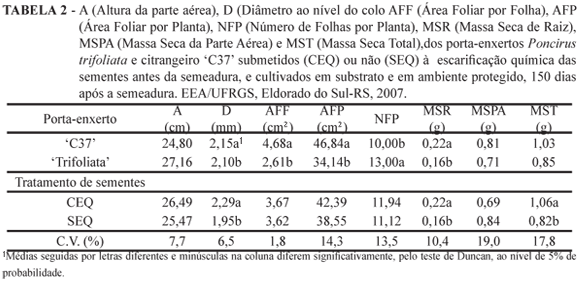The aim of this study was to evaluate emergence and vegetative development of different citric rootstocks derived from chemically scarified seeds. A randomized block design was used in a 2x4 factorial (scarification x rootstocks) with three blocks. Each plot had 20 plastic tubes. The seed chemical treatment was a solution composed by 0.5 L of 12 % sodium hypochlorite (NaClO), 3 mL of chloridric acid (HCl) and 20g of commercial sodium hydroxide (NaOH), dissolved in 1L of water. The evaluated rootstocks were 'Trifoliata'(Poncirus trifoliata [L.] Raf.), citrange 'C37' [Poncirus trifoliata (L.) Raf. x Citrus sinensis (L.) Osbeck.], citrumelo 'Swingle' [P. trifoliata (L.) Raf. x C. paradisi Macf.] and tangerine 'Sunki' (C. sunki hort. ex Tan.). Rootstocks 'Trifoliata' and 'C37' had benefits with tegument chemical scarification, presenting faster seedling emergence, greater seedling emergence rate and greater emergence after 45 days. On the other hand, the rootstocks 'Swingle' and 'Sunki' presented a seedling emergence reduction when their seeds were submitted to chemical scarification in the tegument. Plants 'C37' and 'Trifoliata' from scarified seeds presented diameter and dry mass accumulation significantly higher 150 days after the sowing date, at soil level, as compared to plants derived from intact tegument seeds.
Citrus spp.; propagation; protected environment; seed dormancy; vegetative development



